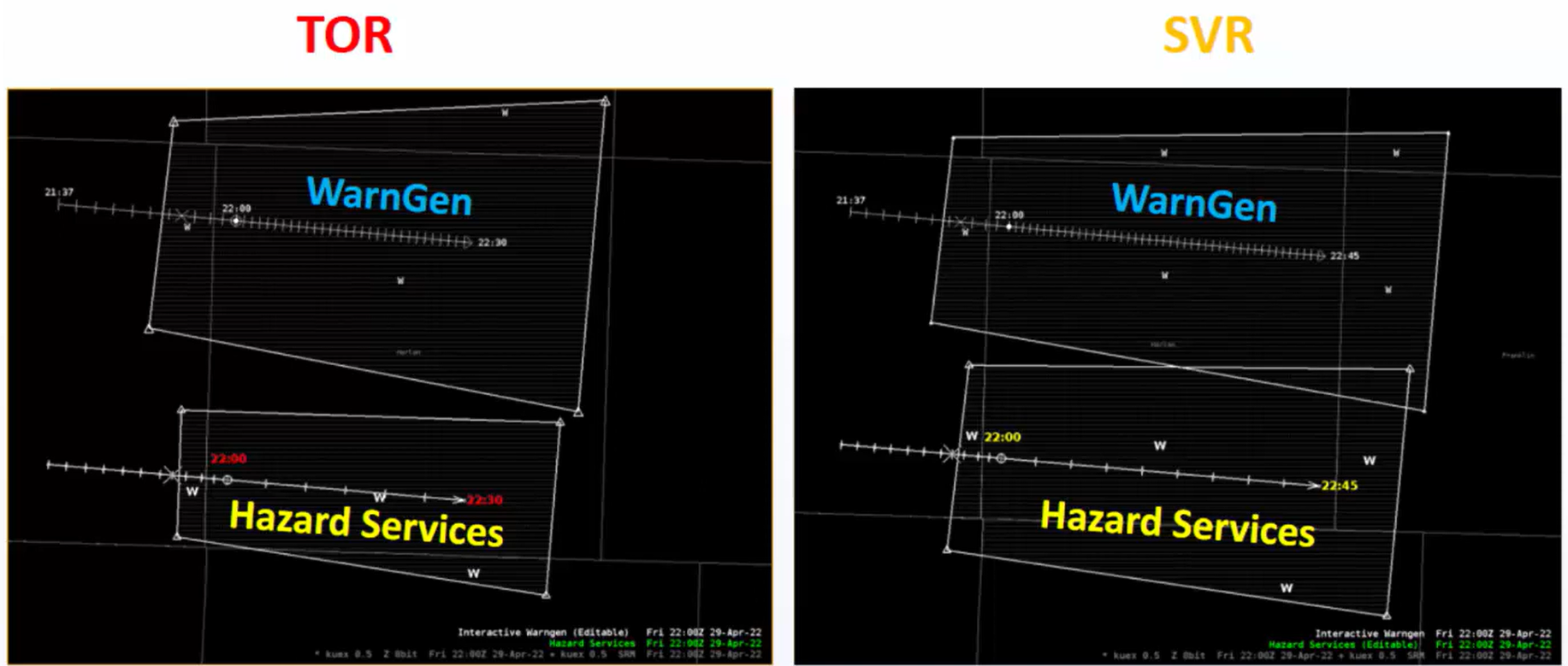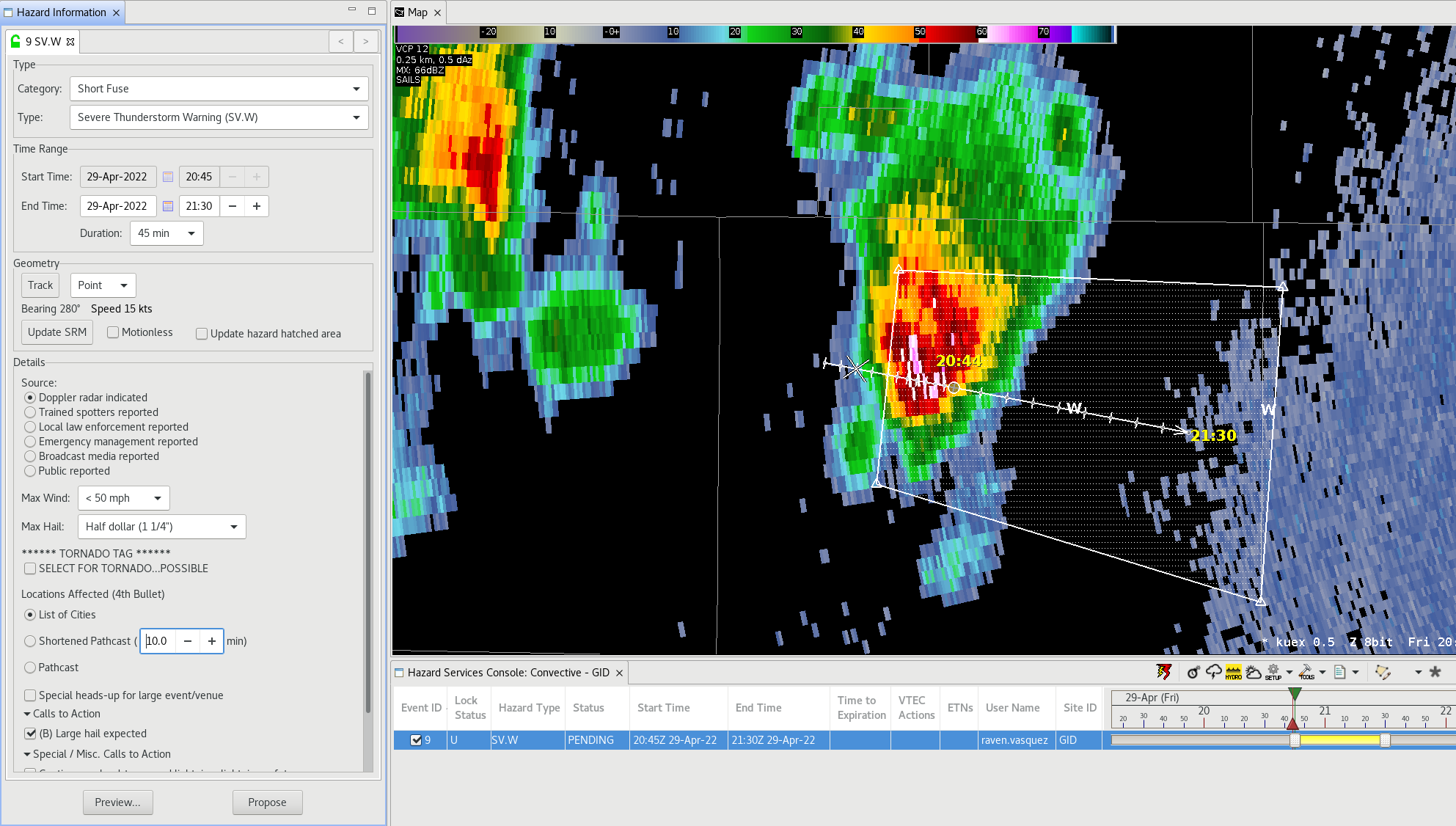WarnGen and Hazard Service Default Polygon Differences and Warning Interoperability - Hazard Services
WarnGen and Hazard Services Default Polygon Differences and Warning Interoperability
Purpose:
This jobsheet will inform forecasters the differences between WarnGen and Hazard Services default short-fused polygons and the process of issuing short-fused products through Hazard Services and following up with an SVS through WarnGen.Tasks:
AT-A-GLANCE:
-
What? In the interim of transitioning from WarnGen to Hazard Services, forecaster may still use WarnGen to issue updates to short-fused hazards. This interoperability only works when a forecaster issues a product through Hazard Services and follows it up by issuing an Severe Weather Statement (SVS) through WarnGen. This will not work if first issued through WarnGen and you attempt to issue an SVS through Hazard Services. It is recommended that forecasters issue products in one program and not mix editing the event between WarnGen and Hazard Services.
-
Polygons There are differences in the default polygon sizes between WarnGen and Hazard Services. Tornado and Severe thunderstorm polygons were the same sizes in WarnGen, however in Hazard Services the defaults are narrower for both, most noticeably for tornado polygons.
First part summarizes the differences between WarnGen and Hazard Services products.
-
In WarnGen the tornado and severe thunderstorm polygons are the same width at the back of the polygon.

- In Hazard Services the polygons are different sizes and the default behavior of drafting polygons is configurable in the StormTrackTool.py localization.
- Tornado warning polygons in Hazard Services have a starting width of 12 km.
- Non-tornado warning polygons in Hazard Services have a starting width of 20 km.
- All polygons have 8 km padding distance at the end of the track arrow.
- All polygons have a 5 km rear extension distance from the tracking dot to the back of the polygon.
 In summary both polygons for SV.W and TO.W are narrower than the default polygons in WarnGen, but the localization files can be edited to change the default polygon generation.
In summary both polygons for SV.W and TO.W are narrower than the default polygons in WarnGen, but the localization files can be edited to change the default polygon generation.
Second part focuses on issuing a short-fused warning with Hazard Services and following up with an SVS through WarnGen.
-
Make sure you are in AWIPS Practice Mode. In this exercise we will start with issuing a warning with Hazard Services. In D2D click the Hazard Services short-fuse icon with the H and red tornado. Run through the process of issuing a Severe Thunderstorm Warning (SV.W) through Hazard Services. After issuing the warning keep Hazard Services open and visible on the screen.

-
Before advancing remember to open up a text workstation. We will then start up WarnGen. Click on the WarnGen icon at the top of D2D. Notice how when WarnGen started up that Hazard Services automatically displayed “Hazard Services is not Editable” in the Console.

We will be following up on the severe thunderstorm warning we just issued with Hazard Services. Under product type select Severe Weather Statement (SVS). In the collection box there will be options to CON or CAN the SV.W. Select CON to continue the warning.

-
The options usually presented in WarnGen when continuing a warning should appear after clicking CON. The threat magnitudes and types should carry over from Hazard Services. Fill out the CTAs or any other options for the SVS. Click Create Text to preview the text product and select Send.
-
The thunderstorm warning SVS should have been issued. In the Hazard Services console you will notice that the User Name for the warning that had an SVS issued through WarnGen had changed. The new name is Interoperability. This is a handy signal that the product has been issued/modified through WarnGen for forecasters using Hazard Services. Highlight the hazard event that was edited with WarnGen in the Hazard Services console.
-
The HID should display an announcement when highlighting the event that states the hazard was created or modified in WarnGen. Because Hazard Services uses metadata, and WarnGen through text information, this event cannot be edited any longer through Hazard Services. This emphasizes the importance of sticking to one software through the lifecycle of the hazard event. Do note that while WarnGen will eventually be phased out in favor of Hazard Services, some offices may still be using WarnGen to issue products. So being familiar with interoperability is important until WarnGen is completely phased out.




